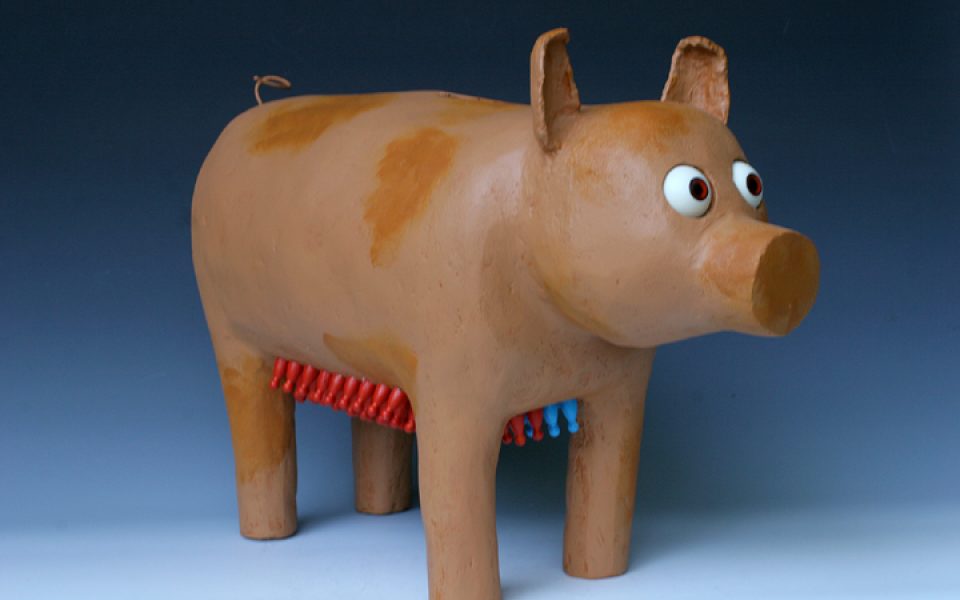Polychrome snakes writhe in the corner enclave while birds chit-chat around delicate, blue-speckled eggs. The red-orange gators drink from a ritual chalice.
These are the subjects of Beauty of the Beast, an ode to our phylogenic brothers and sisters and the latest group exhibit at GreenHill on display through July 15.
Even during the most casual walkthroughs, the exhibition imbues a hit of magical realism — works expressing a predominantly realistic view of the world while incorporating magical elements in seamless ways, especially through allegory to fables and myths. Andy Farkas’ mokuhanga-style woodblock prints are obvious examples, featuring easily-missed messages in tiny golden text. He couples a frolicsome, swinging bird, whose plump form is a tad off, with a brief poem: It came to her/ She didn’t ask for it,/ but neither did she push it away. Just down the line, the gallery features a half swan-half/human holding an elegant pose, and dozens more testaments to the psychological tendency to anthropomorphize, or attribute human characteristics to non-human creatures.

©
Artists take turns sizing our brethren up, naming names as Amanda Nicholas West does in “Expressions of a Thief,” a series of eight fox-skull trophies made of stoneware, contorted faces coated in acrylic.
Some artists borrow more directly from scientific findings and material than others, taking part in artful documentation during ongoing destruction. Matt Zigler’s Natura Technica project serves as a modern-day nod to moralizing, descriptive bestiaries popularized in Medieval era. GreenHill displays an assorted grid of his hand-transferred digital prints, in which layers of digitally collected data — relevant maps, diagrams and habitat scenery — depicts each Latin-named specimen in collage.
A small room houses works from Casey Allen and Jim Kransberger, who match lighthearted forms with searing political commentary. Jim Kransberger’s “PORK.gov,” a mixed-media sculpture of a pink pig — think Platonic piggy bank — features rows of red and blue nipples made from “Sorry” game board pieces.[pullquote]Learn more at greenhillnc.org and visit at 200 N. Davie Street (GSO).[/pullquote]
Bryant Holsenbeck’s colony of grey-headed flying foxes relay a bit of a subtler message from above. These (now) urban wildlife beings are fabricated from trash and undesirable found materials in a fashion at once bestial and endearing. As he alludes, our ever-increasing proximity to these wild ones reminds us we are also of Animalia, the cerebral cousins obsessed with domestication, lost in the dominative charade of “property” and “civility” in opposition to wilderness.

©
Artist Carol Gentithes’ whimsical porcelain mix sculpture “Zoboo Played by Jovian” riffs on this theme. Jovian was a lemur born and raised at the Duke Lemur Center in Durham. Though she sculpted a biologically accurate rendering of Jovian’s head, the surface of his body is finely decorated with scenes of his indigenous Madagascar.
Beauty of the Beasts reveals human shame intrinsically tied to our emergent self-awareness of our place on Earth and in the cosmos. Maybe the more important reveal, though, is a commitment by some to persist in cultivating wonder, and hope, with an eye to reality.
Join the First Amendment Society, a membership that goes directly to funding TCB‘s newsroom.
We believe that reporting can save the world.
The TCB First Amendment Society recognizes the vital role of a free, unfettered press with a bundling of local experiences designed to build community, and unique engagements with our newsroom that will help you understand, and shape, local journalism’s critical role in uplifting the people in our cities.
All revenue goes directly into the newsroom as reporters’ salaries and freelance commissions.


Leave a Reply